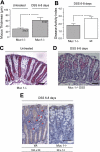Importance and regulation of the colonic mucus barrier in a mouse model of colitis
- PMID: 21109593
- PMCID: PMC3302190
- DOI: 10.1152/ajpgi.00422.2010
Importance and regulation of the colonic mucus barrier in a mouse model of colitis
Abstract
The colonic mucus layer serves as an important barrier and prevents colonic bacteria from invading the mucosa and cause inflammation. The regulation of colonic mucus secretion is poorly understood. The aim of this study was to investigate the role of the mucus barrier in induction of colitis. Furthermore, regulation of mucus secretion by luminal bacterial products was studied. The colon of anesthetized Muc2(-/-), Muc1(-/-), wild-type (wt), and germ-free mice was exteriorized, the mucosal surface was visualized, and mucus thickness was measured with micropipettes. Colitis was induced by DSS (dextran sodium sulfate, 3%, in drinking water), and disease activity index (DAI) was assessed daily. The colonic mucosa of germ-free and conventionally housed mice was exposed to the bacterial products LPS (lipopolysaccharide) and PGN (peptidoglycan). After DSS induction of colitis, the thickness of the firmly adherent mucus layer was significantly thinner after 5 days and onward, which paralleled the increment of DAI. Muc2(-/-) mice, which lacked firmly adherent mucus, were predisposed to colitis, whereas Muc1(-/-) mice were protected with significantly lower DAI by DSS compared with wt mice. The mucus barrier increased in Muc1(-/-) mice in response to DSS, whereas significantly fewer T cells were recruited to the inflamed colon. Mice housed under germ-free conditions had an extremely thin adherent colonic mucus layer, but when exposed to bacterial products (PGN or LPS) the thickness of the adherent mucus layer was quickly restored to levels observed in conventionally housed mice. This study demonstrates a correlation between decreasing mucus barrier and increasing clinical symptoms during onset of colitis. Mice lacking colonic mucus (Muc2(-/-)) were hypersensitive to DSS-induced colitis, whereas Muc1(-/-) were protected, probably through the ability to increase the mucus barrier but also by decreased T cell recruitment to the afflicted site. Furthermore, the ability of bacteria to regulate the thickness of the colonic mucus was demonstrated.
Figures




References
-
- Abreu MT. Toll-like receptor signalling in the intestinal epithelium: how bacterial recognition shapes intestinal function. Nat Rev Immunol 10: 131–144, 2010 - PubMed
-
- Ahn DH, Crawley SC, Hokari R, Kato S, Yang SC, Li JD, Kim YS. TNF-alpha activates MUC2 transcription via NF-kappaB but inhibits via JNK activation. Cell Physiol Biochem 15: 29–40, 2005 - PubMed
-
- Atuma C, Strugala V, Allen A, Holm L. The adherent gastrointestinal mucus gel layer: thickness and physical state in vivo. Am J Physiol Gastrointest Liver Physiol 280: G922–G929, 2001 - PubMed
-
- Backert S, Selbach M. Role of type IV secretion in Helicobacter pylori pathogenesis. Cell Microbiol 10: 1573–1581, 2008 - PubMed
-
- Backhed F, Ley RE, Sonnenburg JL, Peterson DA, Gordon JI. Host-bacterial mutualism in the human intestine. Science 307: 1915–1920, 2005 - PubMed
Publication types
MeSH terms
Substances
Grants and funding
LinkOut - more resources
Full Text Sources
Molecular Biology Databases
Research Materials
Miscellaneous

